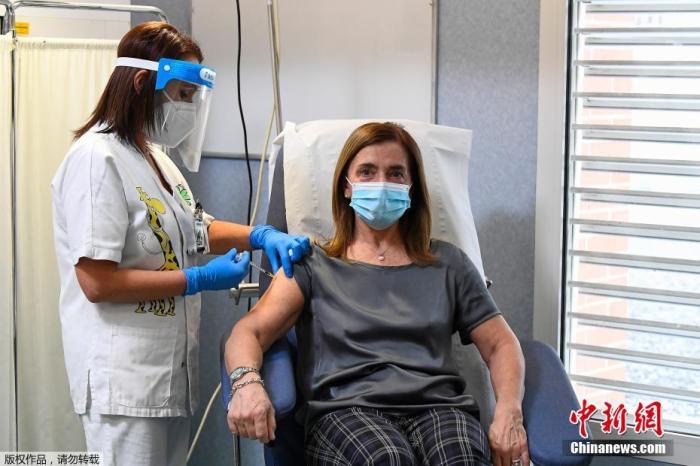(Fighting New Coronary Pneumonia) EU tightens border epidemic prevention and more travelers are included in mandatory testing
China News Service, Brussels, January 25 (Reporter De Yongjian) Due to the emergence of the mutated new crown virus and the increasing number of infections, the EU "dual-pronged" on the 25th announced that it will increase the epidemic prevention efforts at the EU's internal and external borders at the same time. Travelers are included in the scope of mandatory testing for the new coronavirus.
On December 27, 2020 local time, many member states of the European Union officially launched the new crown vaccination work.
The picture shows a medical staff in Italy doing the new crown vaccination work.
According to the announcement issued by the European Commission on the same day, the EU will prevent epidemics at the internal borders between the 27 EU member states (in addition to the four non-EU member states of Switzerland, Iceland, Norway, and Liechtenstein that are part of the Schengen area). The "dark red" risk level is added to the four risk levels of ", green, and gray" to refer to the "extremely high risk areas" of the epidemic. Travelers from these areas are required to go to other EU member states to be tested for the new crown virus and Upon arrival, the country requires isolation.
According to the announcement, the European Union’s “dark red” area is defined as a case-confirmation rate greater than 500 per 100,000 inhabitants within 14 days; in contrast, the EU’s “red” area is defined as a case-confirmed rate greater than per 100,000 inhabitants within 14 days. 150 cases, or the case diagnosis rate within 14 days is equal to or greater than 50 cases, and the positive rate of detection is equal to or greater than 4%, the "orange" area and the "green" area have successively decreased case diagnosis rates within 14 days, and the "gray" area represents insufficient case report data.
Since the EU launched the “red, orange, green, and gray” risk levels in October last year, as the autumn and winter epidemics become increasingly severe, there have been fewer and fewer “green” and “orange” areas, and more and more “red” areas. According to domestic media reports, in view of this, the European Union has decided to further identify the "dark red" regions and fight the epidemic in a more targeted manner through mandatory testing of local travelers.
The announcement also stated that once a place is listed as a "dark red" area by the European Centers for Disease Control and Prevention, relevant member states should increase epidemic prevention efforts, such as requiring home quarantine, temporarily closing commercial premises, etc., and should also improve virus detection, tracking and genetics Sequencing capabilities to collect more information about the mutant new coronavirus.
Regarding epidemic prevention at the EU’s external borders, the European Commission stated in another announcement on the 25th that, except for special circumstances and exempt groups, all persons going to Europe must undergo a nucleic acid test and be issued a negative certificate within 72 hours before boarding. Measures such as centralized quarantine, home quarantine, contact tracing, and additional testing can be taken for these people within 14 days; if the people going to Europe come from a country or region where the mutated new crown virus appears, the member states should especially take centralized quarantine and additional testing after entry. Measures such as testing.
The announcement shows that the above-mentioned mandatory testing order covers not only citizens, long-term residents, family members and other groups of EU member states, but also persons who can make "non-essential travel" to the EU, that is, the EU opens its external borders to the country to which it belongs, and can still go to Europe. Tourist staff.
According to the list updated by the European Union in December last year, these countries include Australia, Japan, New Zealand, Rwanda, Singapore, South Korea, and Thailand. China (including Hong Kong Special Administrative Region and Macau Special Administrative Region) is also included in the list, but with "to EU member states Citizens have equal conditions for opening the border.
(Finish)

